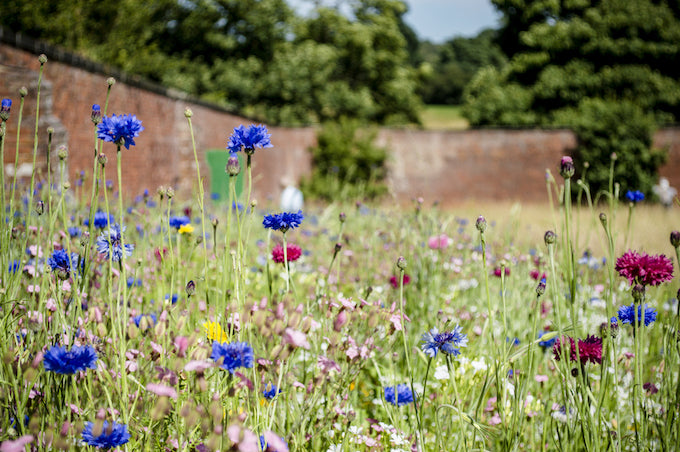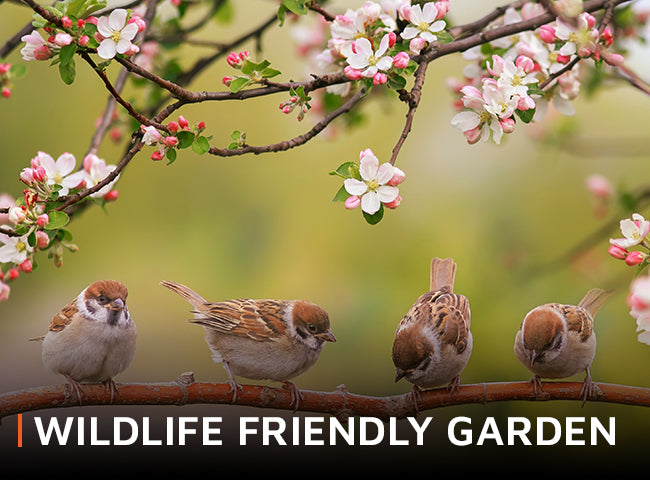Native wildlife is an important part of our natural countryside, but due to intensive farming practices, climate change and urbanisation it’s facing a steep decline. Wild animals and plants are losing their homes as hedgerows are removed and fields and woodlands are lost. Here’s how to make your garden a wildlife-friendly zone.
What’s the problem?

Image source: 1000 words/Shutterstock
The 2016 State of Nature report revealed that more than 10 per cent of the UK’s wildlife is threatened with extinction. In the foreword, Sir David Attenborough said:
The natural world is in serious trouble and it needs our help as never before. We continue to lose the precious wildlife that enriches our lives and is essential to the health and well-being of those who live in the UK.
The good news is that we can all do something to help. There are more than a million acres of private gardens in Britain. Even the smallest outside space or window box can be made into a nature reserve – a sanctuary where plants and animals can find a suitable home. A few containers, hanging baskets or pots can make a huge difference.
Look after the bees

Image source: Stephanie Barlow/Shutterstock
Bees are a vital part of our native ecosystem. They pollinate fruit trees, plants, flowers, vegetables and much more. It’s estimated that pollinators are responsible for £400 million pounds worth of fruit and vegetable production per year.
The number of bees and pollinator insects in the UK has declined dramatically over the last 50 years. This is because there are fewer areas of natural grassland and wildflowers, although chemical fertilisers have also affected numbers.
Growing plants and flowers in your garden to attract bees and pollinator insects is a huge help. They’re most active from late spring spring to late autumn, so this is an important time to grow the things they like. Here are five ways to create a bee-friendly garden:
- Reserve an area where you can sow wildflower seeds.
- Plant a good variety of flowers that bloom from early spring to late summer. Avoid double-petalled varieties as the nectar is hard to reach.
- Leave your lawn a little longer before mowing - bees love dandelions and clover.
- Avoid pesticides, especially those that contain neonicotinoids.
- Make or buy a bee house. Place out of direct sunlight with the entrance facing downwards to prevent rain getting in.
Attract birds to your garden

Image source: Rob Kemp/Shutterstock
Birds bring life, colour and song to your garden, but they also offer natural pest control. They may try to devour your best fruit, but they’ll also help keep on top of slugs, snails and aphids, performing an important role in your garden's ecosystem.
Keeping a feeding station well stocked is the most helpful thing you can do to encourage birds into your garden – the Royal Society for the Protection of Birds (RSPB) recommends feeding them all year round. If that’s not possible, the two most important times to feed are spring, when mothers are caring for their young, and winter when natural food is scarce. Here are five ways to create a bird-friendly garden:
- Provide a good mixed feed all year round, preferably at dawn and dusk.
- Provide clean water for drinking and bathing. A pond with gently sloping sides is ideal if you have space.
- Plant a tree. Even one small tree is appreciated by birds. Grow things such as holly and spindle for winter berries. And try not to get rid of all the nettles - they attract insects that birds love to eat.
- Delay pruning herbaceous and berry-bearing plants until late winter.
- Put a bell on your cat.
Attract hedgehogs to your garden

Image source: Coatesy/Shutterstock
The best time to see hedgehogs in a garden is between April and October. They eat slugs, snails and other pests so they’re a welcome guest. Sadly, their numbers are declining rapidly as natural habitats are destroyed and they find themselves ‘fenced out’ of gardens. If you’re visited by a hedgehog, don't feed it milk or bread which can make it very sick. Some dried pet food and a shallow dish of water should do the trick.
To attract more hedgehogs to your garden, line your boundaries with hedges rather than fences. If you have fences, raise some of them by 15cm or cut little doorways to give wildlife a chance to enter and leave. Get together with neighbours to make a linked ‘highway’ through a whole row of gardens.
Create a safe place for our prickly friends to rest by stacking old bits of wood together to form a pyramid. Hedgehog houses can be any shape, just make sure to put them in a quiet, shady spot and fill them with lots of leaves and grass cuttings – they don't handle heat very well. Hedgehogs hibernate from November to March so a cosy house in a quiet corner where they won’t be disturbed is best. Here are five ways to create a hedgehog-friendly garden:
- Create a safe and accessible ‘hedgehog highway’ through your garden.
- Plant native hedges rather than fences if possible.
- Build or buy a hedgehog house.
- Feed hedgehogs small amounts of dog or cat food. They also loved cooked vegetables.
- Add a pond.
Top tips for creating a wildlife-friendly garden

Image source: adv/Shutterstock
If you want to encourage wildlife into your garden, the most important thing you can do is provide somewhere for them to eat, drink, rest and care for their young:
- Even a single native tree is a great way to encourage wildlife. A small group of trees is even better. Fallen leaves and branches are a favourite place for insects to hide.
- Provide areas of taller grass and wildflowers for insects to shelter and pollinators to feed.
- Ponds provide water for drinking and bathing and encourage a huge variety of wildlife to visit and thrive.
- Plant flowers so that butterflies, bees and birds have a ready selection of nectar, pollen and seeds to enjoy. Plant a combination that gives the longest possible period of flowering.
- Native hedges (eg hazel, hawthorn, blackthorn and holly) provide food, shelter and places to hide and nest.
Creating a wildlife-friendly garden doesn’t mean letting the plants run wild. It needn’t be untidy or unruly. With just a few carefully selected plants and some thoughtful gardening techniques you’ll soon have a host of creatures queuing up to visit!
Lead image: Shutterstock




